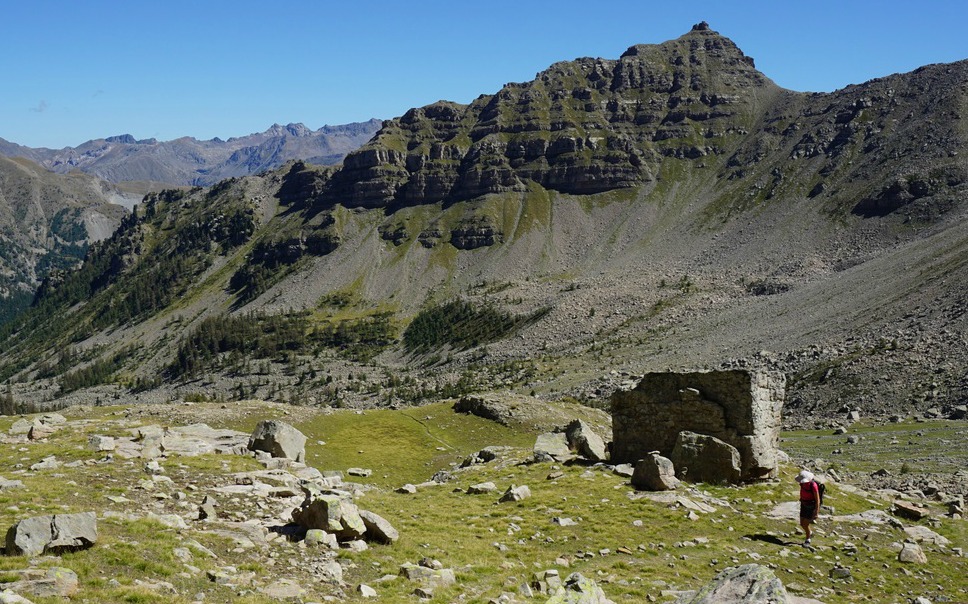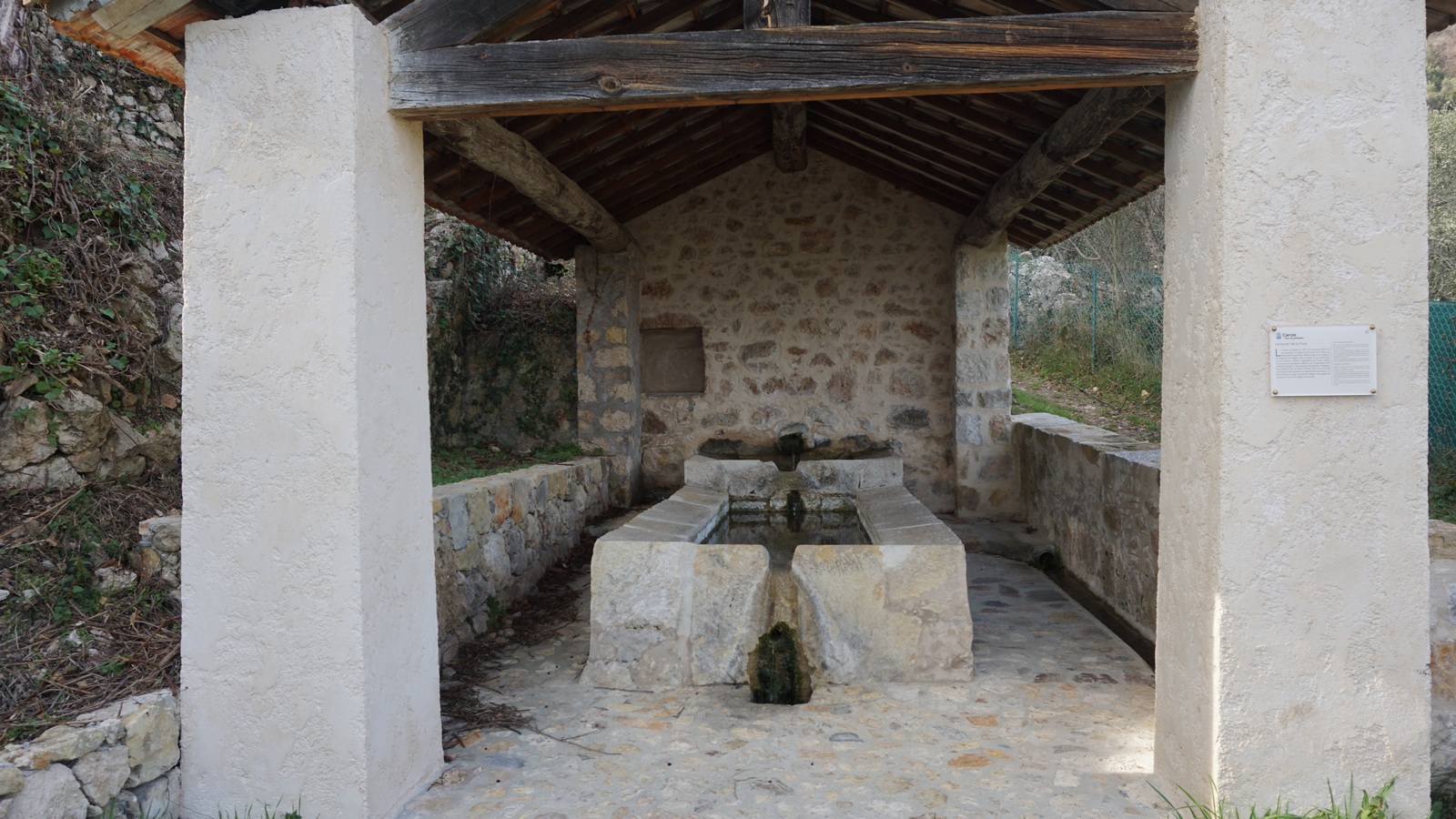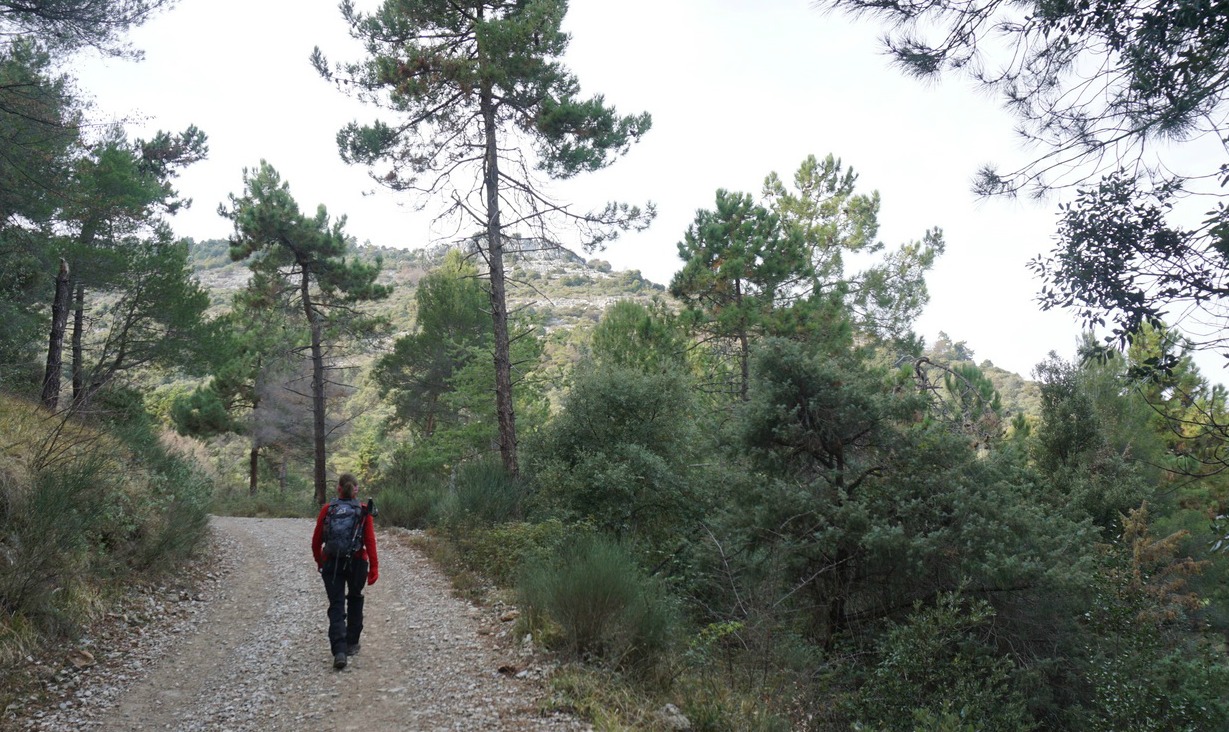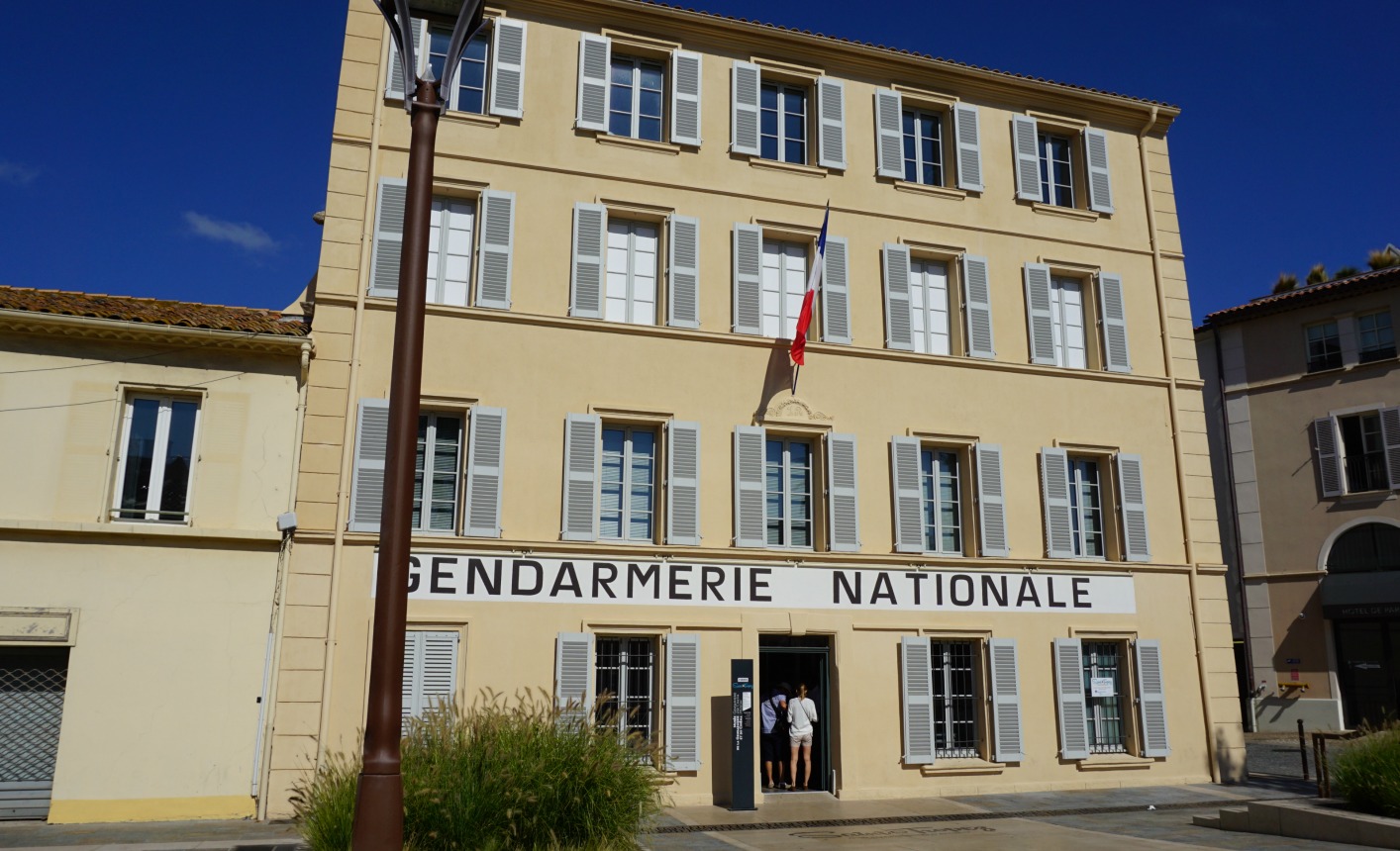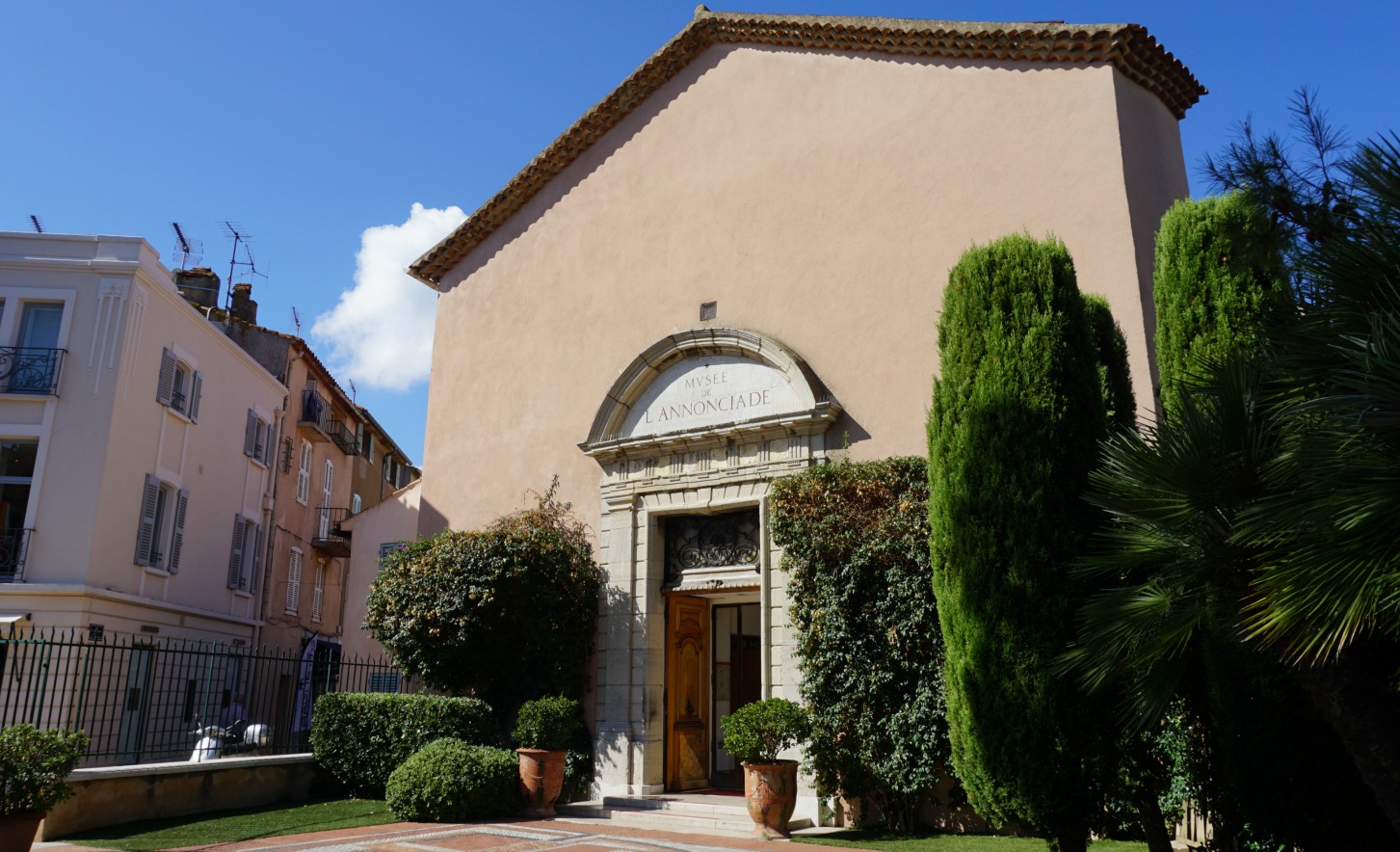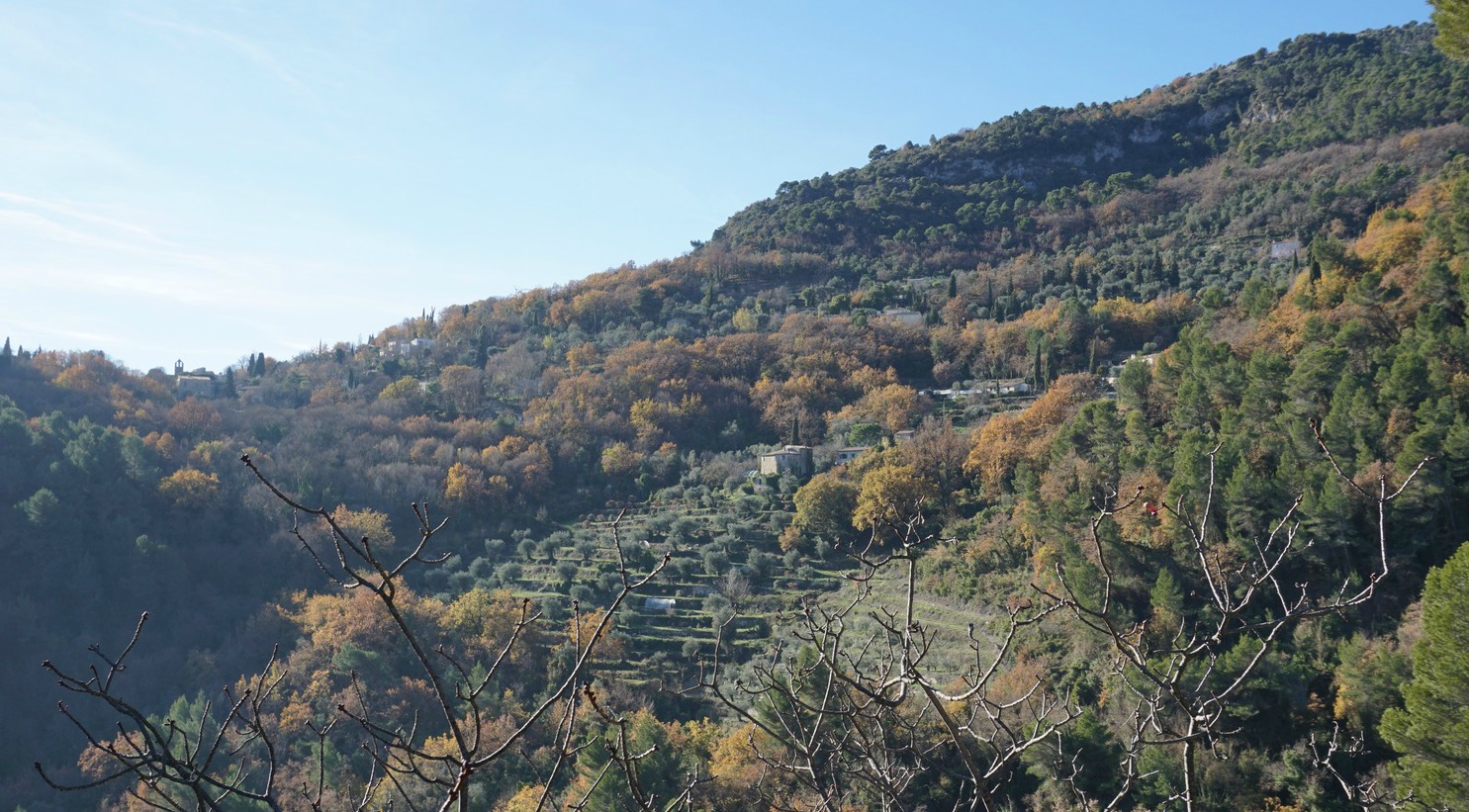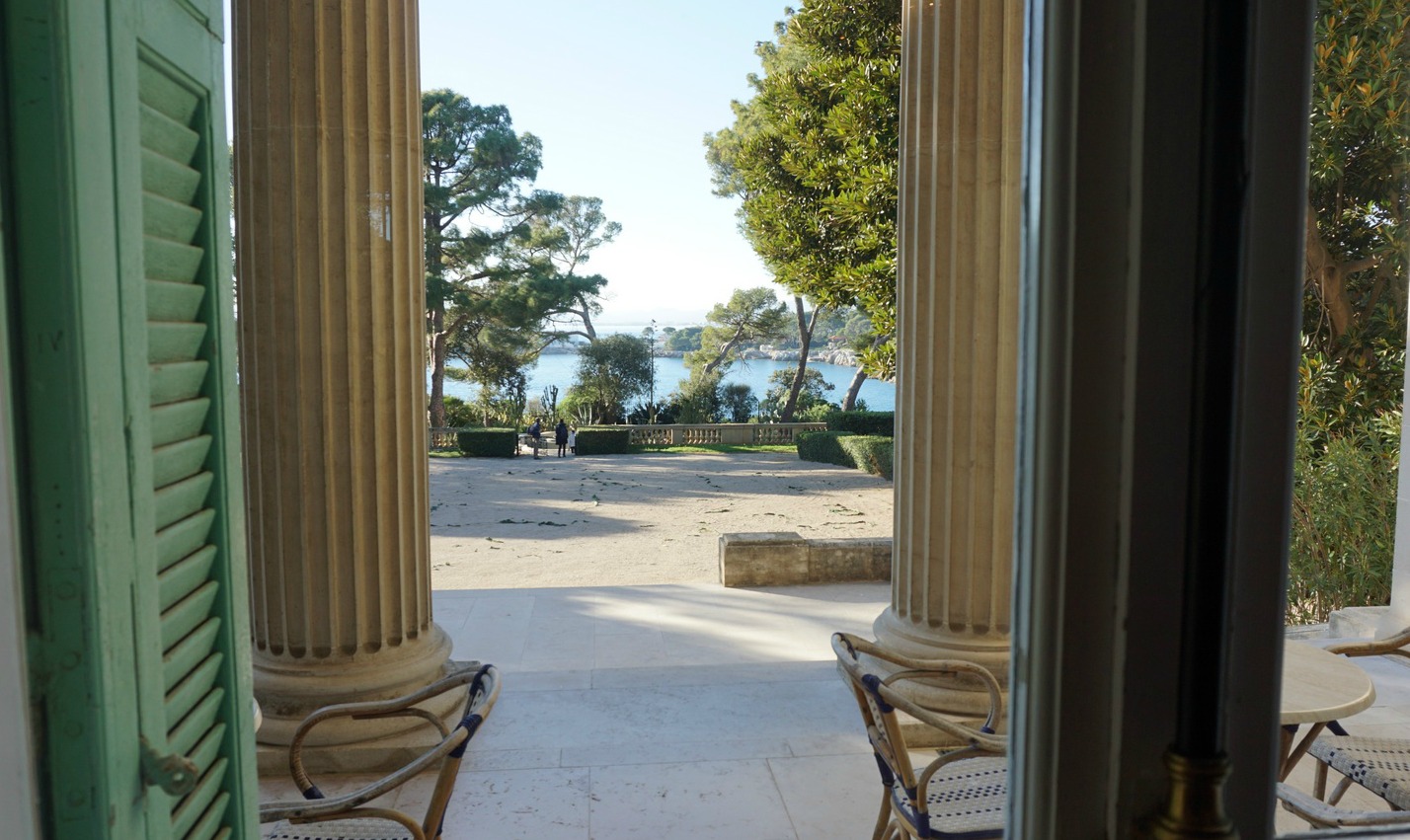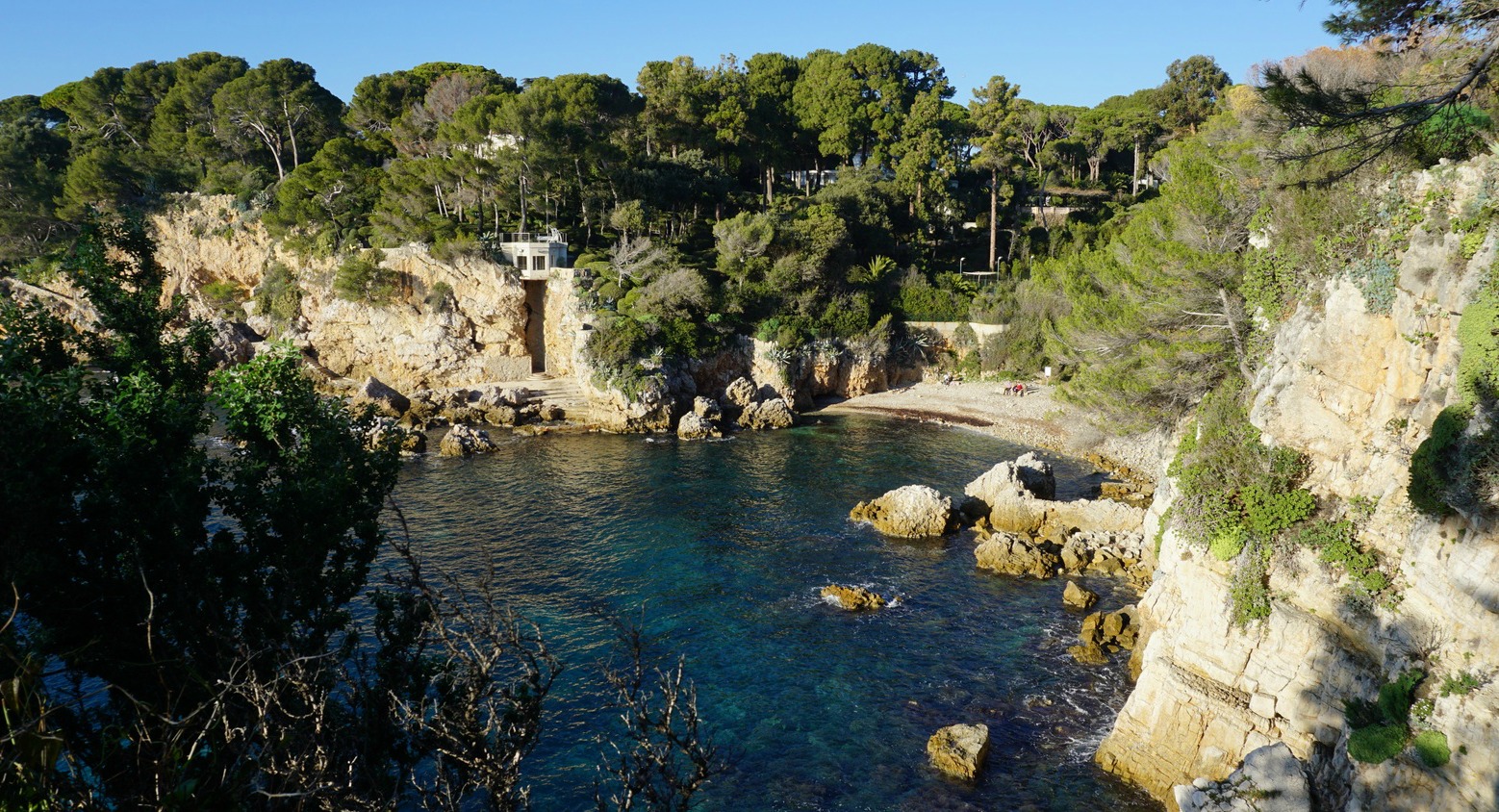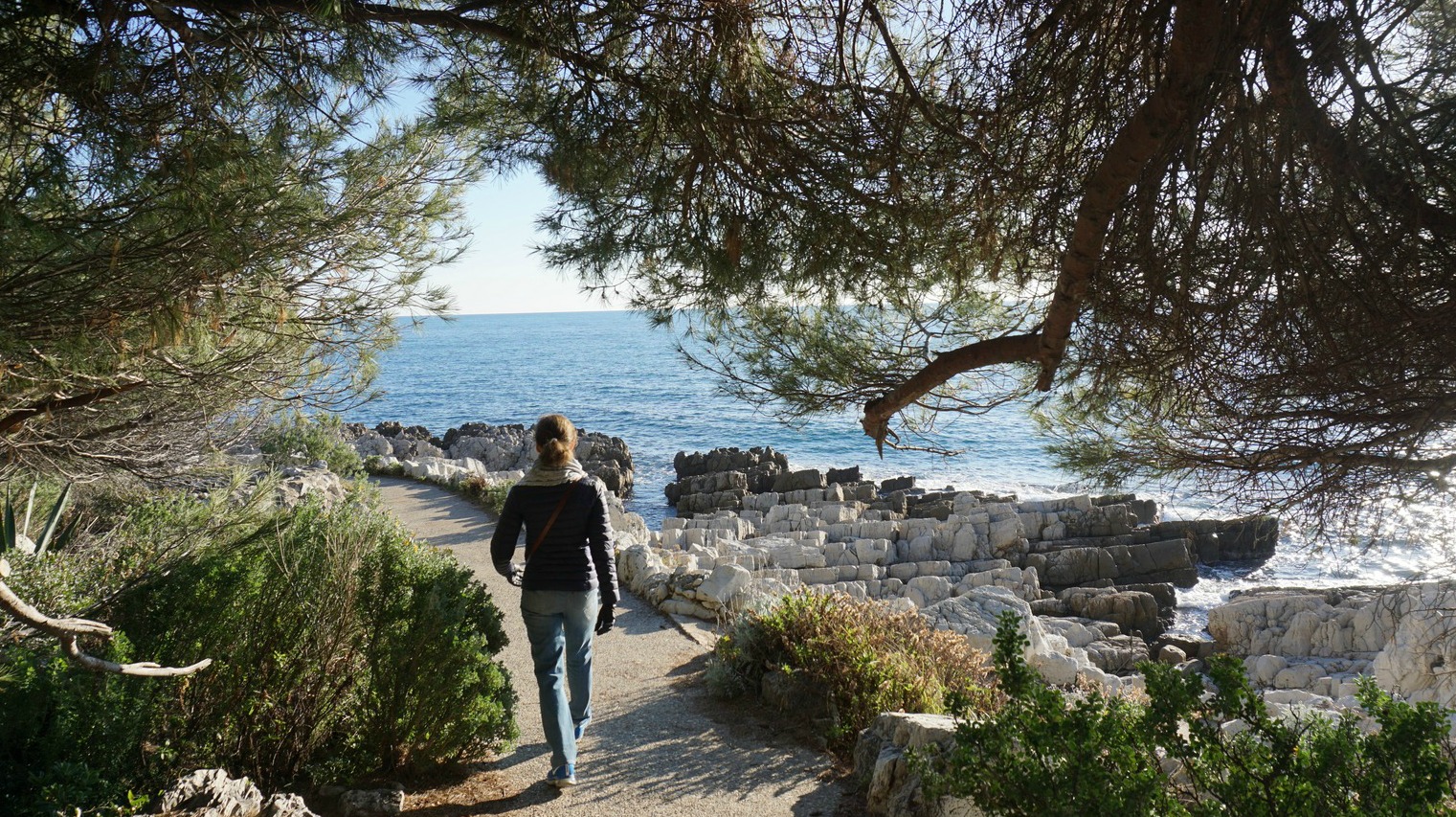Alpine trail above Saint-Dalmas-le-Selvage

We got inspiration for this hike from a French guide (Mercantour Alpes du Sud Le Guide Rando: by Patrick Mérienne). In the book, there was also an excellent description of how the vegetation changes with altitude.
Saint-Dalmas-le-Selvage (1500 m) is a commune and a village in the northern part of Alpes-Maritimes. Two thirds of the commune are inside the Mercantour National Park. It is known as a cross country skiing and a snowshoeing resort in winter, and as a hiking centre during the summer months.
We drove through the village of Saint-Dalmas-le-Selvage, and continued about 6 km along the now narrower D63 road that went to Col de la Moutiére. We parked at 1960 m altitude, not far from the Refuge de Sestrière and signpost #57 which was our starting point. This part of the road was paved, but there was a warning of an unpaved section higher up. The starting altitude was subalpine dominated by larch woods, but also some pines, wild rhododendrons and blueberries. Some larches in this area are said to be over 700 years old. Above 2200 m the vegetation became more alpine with both smooth meadows and rocky areas. Sporadic larches were seen as high as at 2500 m.
The trailhead at signpost #57 was also the entrance to the Mercantour National Park. There were several parking spots by the road, although the one at the signpost was very small.
Thanks to excellent markings by yellow the trail was easy to follow. We crossed a torrent along a footbridge and ascended in the magnificent larch woods for about 40 min before reaching a bigger clearance with Cabane de Braisse by the trail. The trail levelled off a bit, then continued ascending, following a stream, and passing the last larch woods. We came to a section of alpine meadows before the final steeper ascent to the mountain pass where signpost #59 was located. Just below the mountain pass, one trail continued to Col de Sanguiniere nearby, and further to Estenc in the upper Var Valley. The other trail forked north, towards Col de la Moutiére.
We took the same trail back to our starting point.
Vertical ascent: 640 m
Duration: 3h 30 (walking time)
Map: IGN 3639 OT Haute Tinée 1
Driving time from Nice: 1 h 55
Duck breast with winter fruits

Duck breast and fruit is a sure combination. In this
recipe, duck breast is marinated overnight,
and the honey and spices in the marinade add warmth to
the dish. This is comfort food South of
France style on a cold and dark winter evening.
2 servings
1 duck
breast
1 pear,
sliced
1 apple,
sliced
200 ml red
wine
2 tbsp.
raisins
For the marinade:
1 tsp soya
sauce
1 tsp
lavender honey or other runny honey
1 tsp quatre épices (a mixture of ground
cinnamon, ginger, clove, and nutmeg)
The day before
criss-cross the skin-side of the duck breast. Mix the marinade and rub it on
the skin-side. Cover with cling film. Marinate in the fridge for about 24
hours.
The next day
preheat the oven to 200° C.
Place the
duck breast skin-side up in the centre of an ovenproof dish. Slice the apple
and place the slices around the duck breast. Roast in the oven for 15 minutes,
then turn the duck breast and continue roasting for 15 more minutes.
Meanwhile
slice the pear and simmer in red wine for about 20 minutes together with the
raisins.
Steam or
microwave some new potatoes to go with the duck and fruits.
When the
duck breast is cooked, slice it and divide on the plates. Divide the potatoes
on the plates and place the fruits on top.
New loop trail above Carros Village
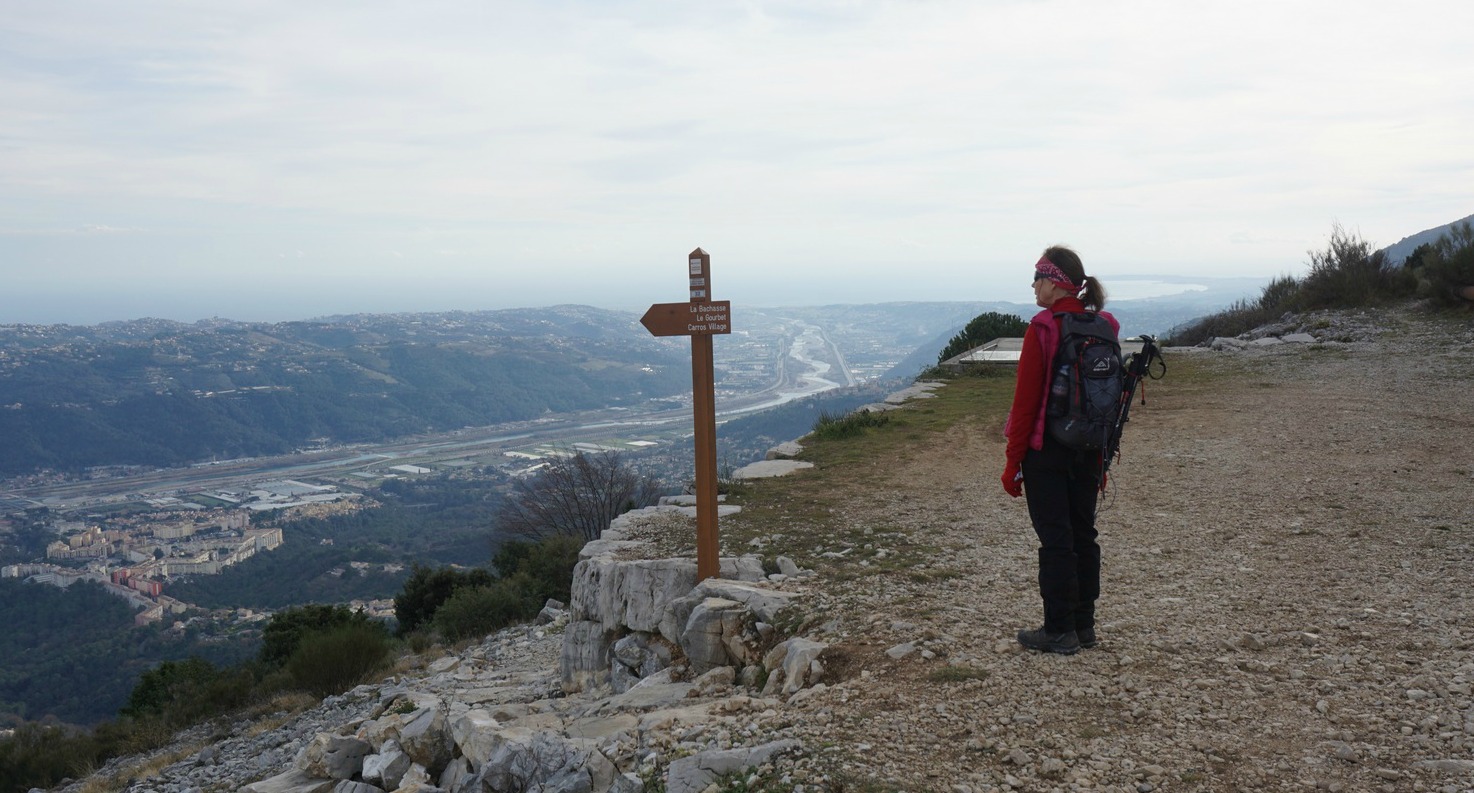
It is not that often that new hiking trails are introduced in Alpes-Maritimes. So when we discovered that a new trail called Les Balcons de Carros was opened above Carros Village, we were eager to test it.
The hike itself is not that long, about 2,5 hours, but nevertheless it gives a good workout because some parts are fairly steep. The trail is very well marked with yellow signs, and with new signposts that don’t exist in older maps.
From the signpost #26 at Carros Village entrance we walked about 50 m along the road to Broc. Then at signpost #27 we started ascending along a small paved pedestrian and cycle route, crossed a small road and continued ascending towards Canal de la Gravière. We soon reached a lavoir (lavoir de la Foux), nicely restored in 2015, and continued our ascent in the woods, now more steeply. At signpost #30 we came to an unpaved forest road, turned left and continued ascending along it.
After a while we came to canal de la Gravière, and continued following it about 200 m to signpost #32. There, an impressive panorama over the Var Valley rewarded us.
From signpost #32 we started descending steeply back towards Carros Village along a recently prepared trail. At signpost #33, we reached the first houses, turned left following a narrow paved road, soon passing the Monastery of Carmel located a bit higher up on the hillside. At this point, navigation was easy as we just followed the yellow marks by the road, and descended back to our starting point.
Duration: 2h 25
Elevation gain: 337 m (GPS data)
Map: 3642 ET Vallée de l’Estéron/Loup
Whiting fillets with mussels, herbs, and white wine

In France, the best season for whiting is in January and February. Whiting in itself is not a very inspiring white fish, it is mainly used in fish cakes, fish pates, coated in breadcrumbs or poached in white wine.
It is the latter method that was used in a video clip shown on the French TV2’s Tele Matin. The dish was cooked outside in the open countryside in a heavy casserole, and with fresh herbs plucked from the hillside.
This recipe is my variation and cooked in my kitchen. The ingredients are simple: olive oil, shallots, garlic, fresh herbs, white wine, fresh mussels and the freshest whiting that I could find. This is a quick one pot dish cooked in my trusted Le Creuset casserole.
2 servings
2 tbsp. olive oil
1 shallot, chopped
1 clove garlic, minced
A handful of different fresh herbs, such as dill, chives and parsley or basil, chopped
100 ml white wine
About 12- 16 cleaned fresh mussels
2 whiting fillets, about 150 g each
In a heavy casserole, warm the olive oil over medium heat and sauté the shallot and garlic for about 5- 10 minutes until softened. Add the white wine and bring to the boil.
Add the chopped herbs and place the whiting fillets in the middle of the casserole. The fillets can be folded because they are so thin. Place the mussels around the fish. Cover and cook about 5- 7 minutes until the fish is opaque and the mussels have opened.
Serve with steamed new potatoes and courgettes.
Visit to Saint-Tropez and a wine store in Gassin
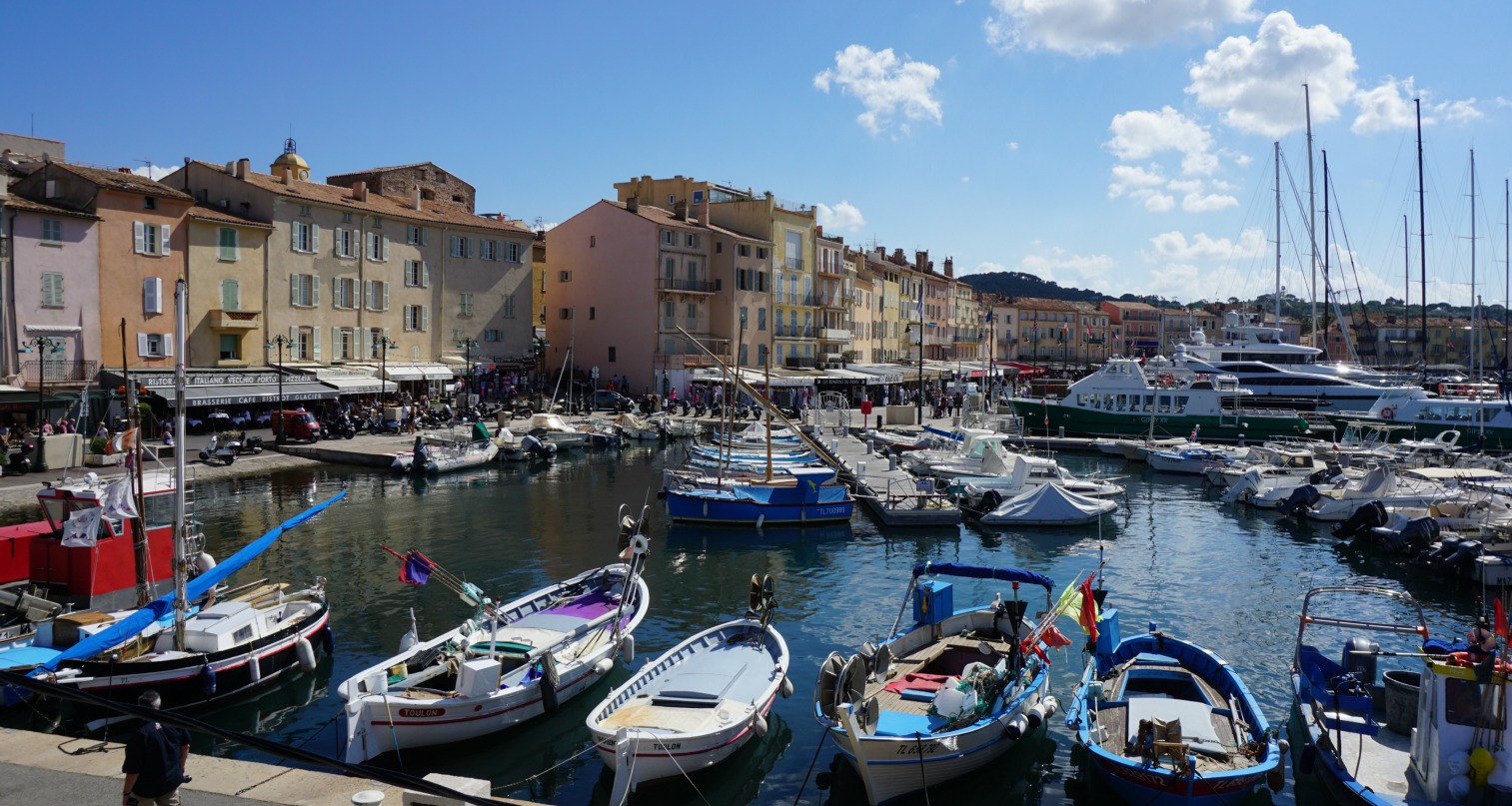
Saint-Tropez is known as the summer playground of international celebrities and people with serious money. But it has an artistic side as well.
We looked forward to this day trip, combining strolling around in Saint-Tropez, art and even a little oenology.
It was the novelist Maupassant who almost accidentally sailed into this little fishing village in the 1880s. He was followed by the impressionist painter Paul Signac. Signac bought a house in Saint-Tropez and many of his painter friends stayed there.
It was originally Signac’s idea to have a permanent exhibition space for the impressionists who painted here. Finally, in 1955, a collection was put together in the Musée de l’Annonciade. A 16th century chapel was transformed to an art museum by the industrialist and art collector Georges Grammont.
We visited this delightful museum situated at the port of Saint-Tropez on a beautiful September day. Paintings of Signac, Matisse, Bonnard and many others were displayed, mostly representing the pointillist, Fauvist and Nabi movements. Incidentally, monumental sculptures by Bernard Bezzina were exhibited outside the museum and elsewhere in Saint-Tropez during our visit.
After lunch at the harbour (plat du jour comprising fresh grilled sardines), we headed to Les maîtres vignerons de la presqu’île de Saint-Tropez, a wine store/winery in La Foux, Gassin. We had read that this wine store specializing in local produce sells the delightful red called Cep d’Or. We had tasted this wine last summer at a small mountain hotel in Queyras and wanted to explore if this or similar red wine could be bought.
Unfortunately, Cep d’Or was discontinued but we could taste two very similar wines:
Les Voiles 2012 AOP Côtes de Provence (70% Syrah, 30% Grenache; 8.95 €) and La Petite Parenthèse 2013 AOP Côtes de Provence (Syrah, Grenache; 6.95 €). They were both nice and light, perfect with poultry and rabbit.
We also tasted 2011 Château de Pampelonne red AOP Côtes de Provence, (A blend of Syrah, Grenache, Carignan, Mourvèdre and Cabernet Sauvignon grape varieties; 12.35 €). This more robust wine would go well even with grilled meat.
Chicken legs with pineapple
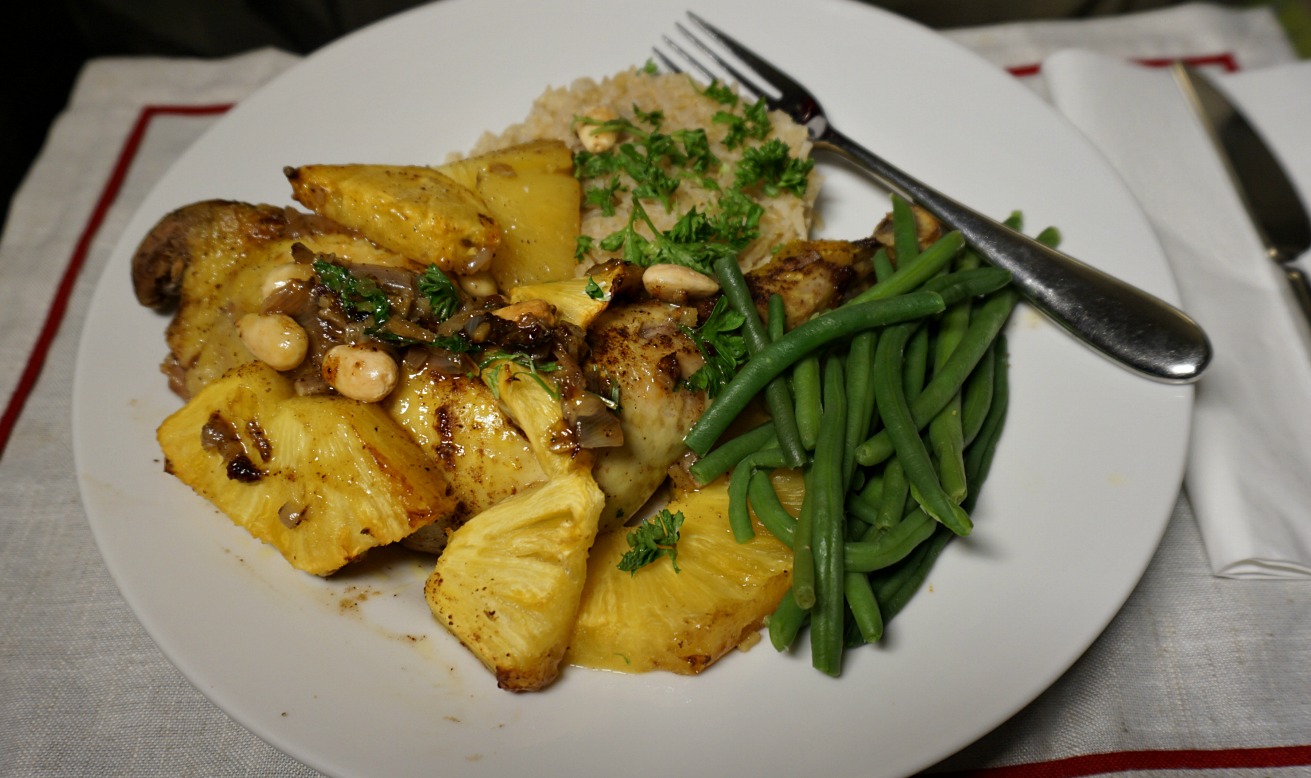
After Christmas tropical fruits appear in our supermarket in Nice. Pineapple, lychee and other exotic fruits are imported from the sunshine to add a warm twist to our midwinter.
The following sunny recipe is modified from a recent recipe in Nice-Matin. Fresh ginger and quatre épices add a nice exotic touch to the recipe. If you cannot find quatre épices in your shops simply substitute it with ground cinnamon and nutmeg.
2 servings
2 free range chicken legs
2 tbsp. olive oil
½ pineapple, sliced
1 shallot, minced
1 clove garlic, minced
1 tsp. quatre épices
2 tbsp. grated fresh ginger
200 ml chicken stock
2 tbsp. peeled whole almonds
Freshly ground black pepper
Fresh parsley to decorate
In a heavy casserole warm the olive oil over medium heat and fry the chicken legs on both sides until golden brown.
Preheat the oven to 200° C.
Add the minced shallot and garlic to the casserole and sauté about 5 minutes until softened. Add the spices, ginger, and chicken stock and stir. Place the pineapple slices on top of the chicken legs.
Transfer the casserole into the oven and bake for 30 minutes. Then sprinkle the almonds on top and continue baking 20 minutes longer. The almonds and pineapple will get a nice golden colour while the chicken underneath stays succulent.
Decorate with parsley and serve with brown rice and green beans.
Carros Village to Chapelle de St-Sébastien

By change we discovered a delightful midwinter walk from Carros Village . The walk offers great views down to the Var Valley, to small villages
on the other side of the River Var, and to the snow-capped Mercantour mountain
tops.
Being this near the Riviera, the trail is surprisingly sauvage, in a natural state. The path is
nevertheless good and well-marked with yellow signs and fresh sign posts
showing the direction to Pont de la Lune
and Chapelle de St-Sébastien.
The trail first descends from the village parking, then
turns left following a paved street for about 150 m before turning left and
further descending steeply in the woods towards Pont de la Lune. When forking
left from the street, we saw a warning not to use the bridge because of the
risk of landslides. However, the trail was not officially closed by the mairie so we continued and wanted to see
the condition of the bridge. The bridge looked renewed, there were other
footprints on the bridge, so we crossed the bridge without any problems. Maybe
the note had been placed after torrential rains earlier this autumn? On the
other hand, in a description from 2012, there were already warnings and the
bridge looked better now! It is possible to take another trail from Carros
Village parking via Chemin de Font Bonne
that runs along the hillside a bit higher. Next to the bridge there are ruins
of an old mill in a bad shape, and going there is not recommended.
From the bridge, the trail ascends fairly steeply, then
crosses the D2209 road. The trail ascends further along a ridge with
unobstructed views and finally joins the D1 road. After about 200 m, the trail
forks left passing a residential area before reaching the chapel. On a sunny
midwinter day, it is a natural spot for picnic while admiring the great views.
At 465 m, the chapel is the highest point of our short hike. We opted to walk
back to Carros Village along a little and quiet road called Chemin du Claret,
and reached our starting point in just about 30 min.
Total walking time: 2 h
Total ascent:
285 m
Creamy potato gratin without cream

Gratin dauphinois, the traditional French potato gratin, was first mentioned in 1788 when it was served at a dinner for the officials of the town of Gap. As with all French local dishes, there are several slightly different recipes. But one thing is common to them all: the gratin is always made with raw, peeled and thinly sliced potatoes. Most recipes are made with considerable amounts of cream, crème fraîche, and some add cheese and eggs so the total calorie content is not negligible.
The following recipe is from a little auberge in Vercors, near Grenoble. It was shown in a French TV programme, Les Carnets de Julie, in which Julie Andrieu and Thierry Marx were trying out different gratin dauphinois recipes.
The potato gratin Vercors style was simply made from raw, peeled and thinly sliced potatoes, whole milk, and salt, no cream at all. They said that you could grate a little nutmeg in the gratin if you wanted, but that was it.
So of course I had to try this simple and calorie-reduced variant. I added some black pepper and crushed garlic in my gratin and dotted the gratin with a small amount of butter. The best French gratin potatoes are said to be Agata, Monalisa, and Nicole, so I chose Agata for my gratin.
The result was creamy and succulent, just as good as gratins made with cream! It is a perfect accompaniment to a good steak, roast beef or duck breast.
4 servings
4 large gratin potatoes
About 600 ml whole milk, to cover the potatoes
About ½-1 tsp. salt
A pinch of nutmeg
2 cloves garlic, crushed
Black pepper
Butter
Choose a slightly larger gratin dish and don’t fill it to the brim; the gratin bubbles and “puffs up” in the oven. Butter generously the gratin dish.
Preheat the oven to 180° C.
Peel the potatoes and slice them thinly. Arrange a layer of potatoes in the bottom of the gratin dish. Sprinkle with salt, black pepper, nutmeg and crushed garlic and pour enough milk to cover the potatoes. Follow with a layer of potato slices and again pour over milk to cover the potatoes.
Dot with a small amount of butter and bake in the oven 1 hour.
Villa Eilenroc and its gardens

It was free to visit Villa Eilenroc and its gardens in Cap d’Antibes the first Wednesday afternoon in January. Villa Eilenroc’s opening hours tend to be a bit erratic; best to check on their web site, or even better to phone in advance (04 93 67 74 33). Built in the 1860s in neoclassic style by a rich Dutchman, the villa is now owned by the city of Antibes. The name of the villa is an anagram of Cornelie, the first owner’s wife.
There’s a very limited parking in front of the entrance so we opted to use the parking of the Garoupe Beach and walk the short distance (less than 20 min) along small and quiet streets.
Naturally January is not the season to visit Villa Eilenroc’s informative rose garden, early May is the best time for that. But the olive tree garden located just behind the rose garden is as great in winter as in summer. In 2000, the commune of Antibes chose to plant 54 Spanish olive trees in a meadow on the premises of Villa Eilenroc. However, don’t expect a perfectly groomed garden as around Villa Ephrussi-Rothschild in Cap Ferrat.
We strolled in the gardens around the villa admiring the beautiful bay of l’Argent Faux before paying a visit to the villa itself. The villa is also used for events such as weddings, fashion shows, and also as a filming location.
The sky was cloudless and the sea calm that afternoon. We decided to walk back along the popular coastal trail around Cap d’Antibes, this time anticlockwise.
Walking time: 2 h, including the visit
Pasta bowl recipe

Bowls are cool! It seems that nowadays more and more dishes are served in bowls: salad, soup, risotto, pasta, breakfast porridge and muesli and so on.
The following pasta bowl recipe makes a quick, tasty and carefree lunch. Don’t worry about the amount of olive oil in the recipe; as ricotta has only 11 % fat you can be a bit more liberal with heart healthy olive oil. The recipe is just as good with smoked salmon instead of Parma ham.
2 servings
2 handfuls of baby salad leaves; baby spinach, rocket, mache or mesclun
4 full tbsp. ricotta
100 g Parma ham or smoked salmon, cut into fine strips
4 tbsp. olive oil
4 tbsp. parmesan
2 tbsp. pine nuts
Freshly ground black pepper
Whole wheat pasta for 2 servings
Cook the pasta al dente.
Meanwhile grate the parmesan and cut the Parma ham or smoke salmon into strips.
In a large bowl carelessly mix the ricotta, Parma ham or smoked salmon strips, 2 tbsp. olive oil and some black pepper. Place the baby salad leaves in 2 individual bowls.
When the pasta is cooked, drain the water and add the pasta into the large bowl. Add the grated parmesan into the bowl and mix carelessly. Divide the mixture on top of the baby salad leaves in bowls. Sprinkle each bowl with 1 tbsp. pine nuts and 1 tbsp. olive oil.
Subscribe to:
Posts (Atom)




